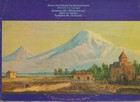
SYMPHONY NO. 14 ('ARARAT'), Op. 194
A VERY UNUSUAL WORK FOR WIND BAND. INSPIRED BY MT. ARARAT, AN EXTINCT VOLCANO NEAR THE ARMENIAN BORDER WHERE NOAH'S ARK CAME TO REST. EARTHQUAKES, AVALANCHES, ROUGH STONES, CAVES, ROCKS SCULPTERED BY TORNADOES INSPIRED THIS SYMPHONY BY ALAN HOVHANESS
highschool bands
jazz bands
college bands
all region bands
community bands
concert bands
honor bands
interlochen arts academy
marching bands
national music camp
tmea all state bands
university bands
Story behind the song
This is performed in 1969 by the North Jersey Wind Symphony, conducted by Keith Brion.
A very unusual work for a wind orchestra, a continuous and dramatic soundpiece unlike the melodious works that many people expect from Hovhaness. "Wild fierceness of volcanic earthquake and avalanche-shaken mountains, rough stones, caves, rocks sculptured by tornadoes inspired this symphony of rough-hewn sounds" (Hovhaness). The beginning of the first movement introduces "rough" tone clusters, and high "dragon fly" clusters leading into simple double counterpoint on pattern-like melodies with a very ancient feeling. The brass take over the melodies antiphonically accompanied by clusters. The music increases in nobility and the intensity of its dissonances. (Hovhaness notes that "in ancient music, sounds of a brief duration touched and released against longer sustained sounds were called "dragon flies" as the dragon fly skims on the surface of the water). The second movement begins with complex orchestra bell patterns against drum punctuations; soon the other instruments join in depicting "lightning and thunder ... dark rumblings grow into a cataclysm of sounds". Crashing drum sounds in complex meters start off the third movement above which six trumpets in unison, and massed dissonance at the end of phrases, sound "a fierce ... cry of mighty peaks". Hovhaness notes that "the poet Isahagian writes of the peak of Mt. Ararat: Infinite lightnings have touched the sword of the diamond."
Alan Hovhaness (born 8 March 1911, died 21 June 2000) was an important 20th Century American composer whose music anticipated many future musical trends and aesthetic values. Rejecting the vogues of Americana, serialism and atonality, he pioneered contemporary development of archaic models and was amongst the earliest to integrate Western musical idioms with Eastern ones, making him a pioneer of East-West 'fusion' decades before the term 'World Music' had been coined. The visionary and mystical nature of his work, often intoxicating in its directness and simplicity, rank him as the musical progenitor to the later, so-called New Age-ists and Spiritual Minimalists.
His parents did not particularly encourage his preoccupation with music but were educated and cultured. Hovhaness began composing during childhood and continued prolifically until old age, despite destroying whole periods of work with which he became dissatisfied. In the 1930s, he studied composition at Boston's New England Conservatory of Music. At this time, he also became fascinated by Eastern music after attending a performance of visiting Indian dancer Uday Shankar. In the 1940s he took serious interest in his paternal Armenian heritage as a means for creative renewal, and studied the works of Armenian composer Gomitas Vartabed and Armenian liturgical music. In the 1950s this influence receded somewhat, and in the early 1960s his trips to India, Japan and Korea added different but equally strong exotic hues to his music. From the 1970s onwards his style became less overtly Eastern.
One of the 20th century's most productive composers, Hovhaness wrote for an unusually wide variety of musical ensembles, from small chamber music to large orchestral works. Even allowing for all his destructive tendencies, he left over 500 published works including 30-odd concertos and around 70 designated symphonies, several with very accomplished but highly individual scoring for large wind ensembles.